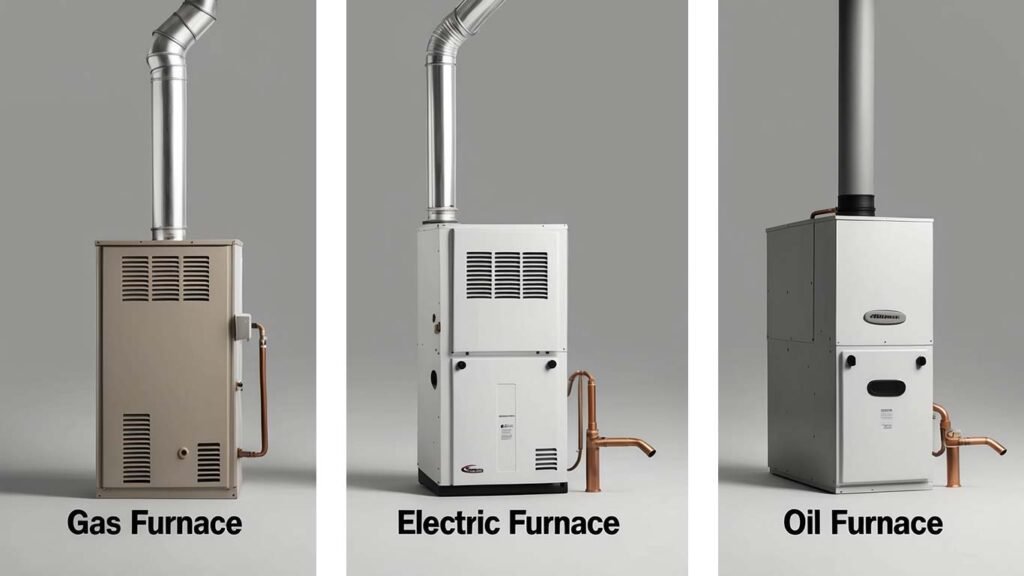What Type of Furnace Do I Have? (Gas, Electric, or Oil?)
Knowing your furnace type is crucial for proper maintenance and efficient operation. Whether your furnace runs on gas, electricity, or oil, each type has unique features that affect how it works and what kind of care it needs. Understanding your furnace type can help you troubleshoot issues, plan for maintenance, and make informed decisions about repairs or replacements.
If you’ve recently moved into a new home or haven’t paid much attention to your furnace before, it might not be immediately obvious what kind you have. Luckily, identifying your furnace type is simple if you know what to look for. In this guide, we’ll show you the key signs to help you figure out if your furnace is gas, electric, or oil, and why this knowledge is essential for keeping your home comfortable.
Check Fuel Source and Connections
- Gas Furnace: A clear indicator of a gas furnace is a gas line running into the unit. You can often spot this line by tracing it to your home’s gas meter or a propane tank. In addition, gas furnaces usually have a metal or PVC vent pipe for exhausting gases outside.
- Electric Furnace: Electric furnaces don’t have a gas line or external fuel connections. Instead, they are connected directly to your home’s electrical system. They typically feature electrical panels or breakers nearby for power control.
- Oil Furnace: Oil furnaces will always connect to an oil storage tank inside or outside the home. A visible fuel line connecting the tank to the furnace indicates the use of oil.
Verify the Heating Mechanism
- Gas Furnace: Gas furnaces generate heat through combustion, using a series of burners that ignite natural gas or propane. This produces a visible flame, and you’ll likely hear the sound of gas flowing and igniting when the furnace is in operation.
- Electric Furnace: Electric furnaces use heated coils or elements to warm the air. Unlike gas or oil furnaces, there are no flames involved. These systems are often quieter when running since they rely on electric resistance heating.
- Oil Furnace: Oil furnaces use a fuel burner that atomizes the oil and ignites it to produce heat. The ignition process can be louder than gas or electric systems, and you may hear the burner firing up.

Look for the Exhaust System
- Gas Furnace: Gas furnaces require venting to expel the byproducts of combustion. A flue or exhaust pipe directs these gases outside your home. This important safety feature prevents harmful gases like carbon monoxide from accumulating indoors.
- Electric Furnace: Electric furnaces do not produce combustion gases and, therefore, don’t require a venting system. The absence of an exhaust pipe is a quick indicator that your furnace is electric.
- Oil Furnace: Similar to gas furnaces, oil furnaces have an exhaust system for venting the byproducts of oil combustion. Look for a vent pipe that runs outside, often through the roof or wall.
Analyze the Thermostat Settings and Controls
- Gas Furnace: Gas furnaces often have controls related to gas flow, igniters, and possibly a pilot light reset. These controls are usually located near the furnace.
- Electric Furnace: Electric furnaces typically have simpler controls since they operate through electricity. You won’t find gas-related settings or igniters, making it easy to distinguish from gas systems.
- Oil Furnace: Oil furnaces have additional controls for managing the fuel pump and ignition system. If your furnace has oil-specific controls, it’s another indicator that your system runs on oil.
Pay Attention to Distinct Smells During Operation
- Gas Furnace: While gas furnaces shouldn’t produce strong odors, you may occasionally detect a faint smell of gas during startup or if there’s a small leak. However, a strong gas smell indicates a more serious issue and requires immediate attention.
- Electric Furnace: When functioning properly, electric furnaces are virtually odorless. If there’s any smell, it could indicate an electrical issue, such as overheating components.
- Oil Furnace: Oil furnaces often have a distinct smell of burning oil, especially when first starting up. This is a normal part of the combustion process for oil furnaces.
Why Knowing Your Furnace Type Matters
Understanding your furnace type is more than just knowing how it works. It is key to caring for and maintaining your system.
For example, gas furnaces require regular checks for gas leaks and proper venting, while electric furnaces need attention to heating elements and electrical connections. Oil furnaces demand specific care related to fuel delivery and burner maintenance.
Knowing your furnace type allows you to troubleshoot more effectively and make informed decisions about when to call a professional for help. It also helps you understand the costs and environmental impact of your heating system, enabling you to explore energy-saving upgrades or replacements in the future.
Call Air Control Services for Professional Assistance
If you’re having trouble determining your furnace type or need professional maintenance, Air Control Services in Las Cruces, NM, is here to help. Our HVAC technicians can identify your heating system, provide the necessary maintenance, and help you explore energy-efficient options if you’re considering an upgrade.
Don’t leave your furnace’s care to chance!
Call (575) 636-2754 for professional assistance.
